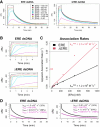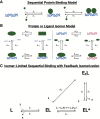Transcription factors ERα and Sox2 have differing multiphasic DNA- and RNA-binding mechanisms
- PMID: 38760076
- PMCID: PMC11251522
- DOI: 10.1261/rna.080027.124
Transcription factors ERα and Sox2 have differing multiphasic DNA- and RNA-binding mechanisms
Abstract
Many transcription factors (TFs) have been shown to bind RNA, leading to open questions regarding the mechanism(s) of this RNA binding and its role in regulating TF activities. Here, we use biophysical assays to interrogate the k on, k off, and K d for DNA and RNA binding of two model human TFs, ERα and Sox2. Unexpectedly, we found that both proteins exhibit multiphasic nucleic acid-binding kinetics. We propose that Sox2 RNA and DNA multiphasic binding kinetics can be explained by a conventional model for sequential Sox2 monomer association and dissociation. In contrast, ERα nucleic acid binding exhibited biphasic dissociation paired with novel triphasic association behavior, in which two apparent binding transitions are separated by a 10-20 min "lag" phase depending on protein concentration. We considered several conventional models for the observed kinetic behavior, none of which adequately explained all the ERα nucleic acid-binding data. Instead, simulations with a model incorporating sequential ERα monomer association, ERα nucleic acid complex isomerization, and product "feedback" on isomerization rate recapitulated the general kinetic trends for both ERα DNA and RNA binding. Collectively, our findings reveal that Sox2 and ERα bind RNA and DNA with previously unappreciated multiphasic binding kinetics, and that their reaction mechanisms differ with ERα binding nucleic acids via a novel reaction mechanism.
Keywords: DNA; RNA; kinetics; transcription factor.
© 2024 Hemphill et al.; Published by Cold Spring Harbor Laboratory Press for the RNA Society.
Figures










Update of
-
Transcription factors ERα and Sox2 have differing multiphasic DNA and RNA binding mechanisms.bioRxiv [Preprint]. 2024 Mar 19:2024.03.18.585577. doi: 10.1101/2024.03.18.585577. bioRxiv. 2024. Update in: RNA. 2024 Jul 16;30(8):1089-1105. doi: 10.1261/rna.080027.124. PMID: 38562825 Free PMC article. Updated. Preprint.
Similar articles
-
Transcription factors ERα and Sox2 have differing multiphasic DNA and RNA binding mechanisms.bioRxiv [Preprint]. 2024 Mar 19:2024.03.18.585577. doi: 10.1101/2024.03.18.585577. bioRxiv. 2024. Update in: RNA. 2024 Jul 16;30(8):1089-1105. doi: 10.1261/rna.080027.124. PMID: 38562825 Free PMC article. Updated. Preprint.
-
RNA fine-tunes estrogen receptor-alpha binding on low-affinity DNA motifs for transcriptional regulation.EMBO J. 2024 Nov;43(21):5186-5210. doi: 10.1038/s44318-024-00225-y. Epub 2024 Sep 16. EMBO J. 2024. PMID: 39284910 Free PMC article.
-
Concurrent binding to DNA and RNA facilitates the pluripotency reprogramming activity of Sox2.Nucleic Acids Res. 2020 Apr 17;48(7):3869-3887. doi: 10.1093/nar/gkaa067. Nucleic Acids Res. 2020. PMID: 32016422 Free PMC article.
-
Impact of protein/protein interactions on global intermolecular translocation rates of the transcription factors Sox2 and Oct1 between DNA cognate sites analyzed by z-exchange NMR spectroscopy.J Biol Chem. 2012 Aug 3;287(32):26962-70. doi: 10.1074/jbc.M112.382960. Epub 2012 Jun 20. J Biol Chem. 2012. PMID: 22718759 Free PMC article.
-
ERα-associated protein networks.Trends Endocrinol Metab. 2011 Apr;22(4):124-9. doi: 10.1016/j.tem.2010.11.005. Epub 2011 Mar 2. Trends Endocrinol Metab. 2011. PMID: 21371903 Review.
Cited by
-
A Distinct Mechanism of RNA Recognition by the Transcription Factor GATA1.Biochemistry. 2025 Mar 18;64(6):1193-1198. doi: 10.1021/acs.biochem.4c00818. Epub 2025 Feb 25. Biochemistry. 2025. PMID: 39999571
References
-
- Chassaing N, Causse A, Vigouroux A, Delahaye A, Alessandri J-L, Boespflug-Tanguy O, Boute-Benejean O, Dollfus H, Duban-Bedu B, Gilbert-Dussardier B, et al. 2014. Molecular findings and clinical data in a cohort of 150 patients with anophthalmia/microphthalmia. Clin Genet 86: 326–334. 10.1111/cge.12275 - DOI - PubMed
MeSH terms
Substances
Grants and funding
LinkOut - more resources
Full Text Sources
Miscellaneous
